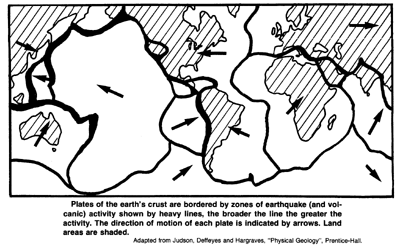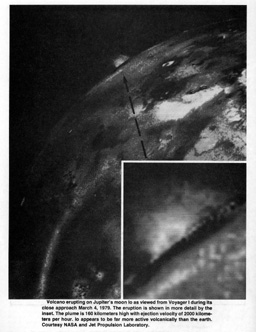|
It's a Nice Planet to Visit, but I Wouldn't Want to Live There
By: Virginia Trimble
 As all dedicated vacationers know, you can stand anything for two weeks. But most of us become more particular when choosing a long-term residence, and downright fussy as we begin to think about where we want to raise our children. The macrocosm of life is rather like this microcosmic example. Terrestrial life in one form or another can survive for at least a while under a much wider range of conditions than those under which it could have evolved. And (we hope that!) human civilization will be able to
endure circumstances that would surely have kept our ancestors cowering in their caves, or even wiped them out completely.
As all dedicated vacationers know, you can stand anything for two weeks. But most of us become more particular when choosing a long-term residence, and downright fussy as we begin to think about where we want to raise our children. The macrocosm of life is rather like this microcosmic example. Terrestrial life in one form or another can survive for at least a while under a much wider range of conditions than those under which it could have evolved. And (we hope that!) human civilization will be able to
endure circumstances that would surely have kept our ancestors cowering in their caves, or even wiped them out completely.
What, then, must a planet supply for life to be able to develop, survive, and evolve to intelligence on it? Charles Darwin's warm little pond is a good start:
".... conceive in some warm little pond, with all sorts of ammonia and phosphoric salts, light, heat, electricity, etc., present, that a protein compound was chemically formed ready to undergo still more complex changes ...."
That is, we seem to need liquid water (constraining both temperature and composition), a high-grade energy source, suitable raw materials (including carbon and hydrogen compounds, but no free oxygen), and lots of time.
Astronomers, looking at stars and the process of star formation from interstellar gas (which is surprisingly rich in a wide variety of carbon compounds) have generally concluded that these essentials should be available in many places; while biochemists have verified with laboratory experiments that the initial stages of the chemistry leading to proteins, nucleic acid, and so forth do actually occur in such a pond. The implications of these observations and experiments for the frequency of life-bearing planets in the galaxy have been frequently, and usually optimistically, explored in this publication and many others. It is usually assumed that time is not really a problem, because the oldest stars in our galaxy are three or four times the age of our sun. The catch is that these stars (hence, perhaps, their planets, if any) have only about 1 percent as much of the chemical goodies needed for life (carbon, nitrogen, phosphorus, etc.) as the sun does. Thus, the oldest chemically suitable stars may not be much older than our 4.6 billion year sun. A closer look at how life probably got started on earth suggests a number of other plausible constraints.
I want here to focus particularly on the extent to which the appearance of intelligent, technological life on earth may have depended on the existence of plate tectonics.
Plate-tectonics-and-continental-drift, which ascended from the realm of crankiness to that of dogma with extraordinary rapidity less than 20 years ago, is a sort of catch-all phrase to describe what most geophysicists now think are the dominant processes happening on the surface of the earth. Of the ideas that make up the dogma, the ones that will concern us here are:
(a) continental rocks (granites) are less dense than ocean basic rocks (basalts) and float upon them,
(b) the earth's surface is broken into a number (about 10 large and a few dozen small) plates of solid rock, typically
containing both land and ocean basin, a few miles thick and hundreds to thousands of miles across,
(c) these plates are dragged around on the surface of the earth essentially by the flow of less rigid (but still solid) rocks underneath them in the earth's mantle,
(d) where plates spread apart, molten rock rises and forms new ocean basins (this is happening now in the mid Atlantic and elsewhere),
(e) where plates slide past each other, general unpleasantness occurs (the San Andreas fault of Southern California is the classic example),
(f) where plates crash into one another, continental rock is piled up into mountains (the Andes and Himalayas are regions where this is happening now; the Appalachians and Urals are relics of ancient collisions), while ocean basin rock can be dragged back down into the mantle and remelted, giving rise to volcanoes and considerable chemical reprocessing of the rock (as is now occurring around most of the rim of the Pacific Ocean),
(g) this sort of thing has been going on for most of the age of the earth, breaking apart old continents, forming new ones out of the fragments, and generally messing things up thoroughly, and
 (h) energy to keep this going comes from the interior heat of the earth, which in turn is partly left over from its formation and partly maintained by the decay of radioactive atoms inside. Boundaries of the present plates are marked out by the presence of volcanoes and earthquakes (as shown in the diagram).
(h) energy to keep this going comes from the interior heat of the earth, which in turn is partly left over from its formation and partly maintained by the decay of radioactive atoms inside. Boundaries of the present plates are marked out by the presence of volcanoes and earthquakes (as shown in the diagram).
Suppose plate tectonic processes were to stop (as must eventually happen when the earth cools off) or had never occurred (as would be the case if the earth had started with a smaller mass, like the moon, or had contained smaller amounts of radioactive elements). Could we continue to live here, could we have evolved to something like our present biological state, and could our civilization (such as it is) ever have developed? The answer to all three questions may well be no. Let's look at three products of plate tectonics that seem to matter. These are (a) the maintainence of the balance between land and water, (b) the provision of a wide range of habitats, and (c) the production of high-grade metallic ores.
If plate tectonics turned off, the first to suffer would be the skiers and climbers, as the taller mountains eroded away over 10 million years or so. After a few hundred million years (this is still short compared to the 4.6 billion year age of the earth) essentially all the land would be eroded below sea level, and eventually the oceans should cover the entire earth's surface to a uniform depth of a few miles (as would always have been the case if there had never been any tectonics). One can imagine a portion of humanity developing under-water cities and surviving this, but it is much harder to conceive of civilization arising under these circumstances. Dolphins, though endowed with impressively large brains in relationship to their body weights, are not tool makers or even (like many primates and other, lower, land animals) tool users. In fact evolution could not have taken anything like its actual course. Though many of our remote ancestors were ocean dwellers, they preferentially inhabited the shallow continental shelf regions, not the ocean deeps, as do the vast majority of marine organisms to this day. Even the chemical reactions that were, in some sense, our earliest ancestors probably require shallow water, with sunlight and muddy bottom not too far apart. Perhaps we should stop here and conclude that plate tectonics is surely essential for life to develop. There may be a way out, though, via a planet on which water is less abundant than on earth (but more so than on Mars today), so that the surface irregularities produced by meteorite impacts are sufficient to keep some areas dry and others wet. Photographs of Mars suggest that it may have been like this not too long ago.
Plate tectonics introduces continuous change into both the number and types of habitats available for living creatures as continents and their shelves emerge, collide, and break apart again. Evolution can surely occur without this, but it will be different. Isolated populations, for instance on tropical islands, tend to be rather fragile, both flora and fauna being likely to succumb before species introduced from a larger, continental environment. In addition the fossil record shows interesting correlations with the positions of the continental plates in the past. When most of the land was in a single continent, diversity of species (both land and shelf dwelling) tended to be small, while existence of several smaller continents is accompanied by a wider range of living creatures. Evidently, when continents collide, species previously free of competition meet, and not all of them survive, producing a wave of extinctions (several of which appear in the fossil record over the past 600 million years). And when continents break apart, new, unoccupied habitats open up, and new species develop through adaptive radiation into the new territory. We are ourselves somewhat the product of such radiation, occurring when the opening of the Atlantic 60 million or so years ago separated the ancestors of the present New World monkeys from those of the Old World monkeys and apes. The result must in general be more rapid evolution than would otherwise occur. Given enough time, this shouldn't matter to the eventual appearance of intelligent life. But, as noted above, recent evidence suggests that there may not be very many stars that are both generously endowed with the elements needed for life and much older than the sun. And it has, after all, taken us the entire age of the solar system to get to where we are now!
Finally, most theories of planet formation suggest that the earth was originally chemically uniform, the iron-nickel core separating from the rockier outer layers as radioactive decay heated and melted the interior. This still leaves the rocky regions more or less well-mixed. The wide range of minerals and ores we find on earth are, to a considerable extent, a direct result of melting, recrystallizing, dissolving and precipitating from water solutions of materials at and near plate boundaries (especially converging ones). Thus nearly pure copper occurs in Cyprus where the African plate is pushing into the European and lead, silver, and molybdenum ores are found in sequence across the western United States, where the East Pacific divergent boundary has disappeared under North America. The development of some aspects of technological civilization would seem to be rather heavily dependent on availability of such ores. The example that comes immediately to mind is the need for good conductors of electricity if one is ever to discover Maxwell's equations of electromagnetism and the technology of radio broadcasting and receiving (the method most often suggested for interstellar communication). There are non-metallic conductors (including salt water and ourselves), but if the typewriter on which this is being written had to be plugged into the salt water line, I think I would just as soon skip the whole thing!
 Examination of other members of the Solar System tells us that tectonic processes are by no means universal. The moon and Mercury are dead in the tectonic sense, their surface features largely attributable to meteorite impacts. Venus and Mars show what may be dead volcanoes and faults, but seem to have little or no activity now. The giant gas planets have no solid surface to be broken into plates. But the earth is not quite unique, either. In spring 1979, Voyager began sending back pictures of Jupiter and its moons. And one of these, Io, had no less than 7 volcanoes in eruption at once (the terrestrial average is more like one). They are not much like our volcanoes, because Io has long since boiled away all its water and similar light compounds (it is much less massive than the earth, so its gravity holds on to things less tightly). But they are volcanoes, suggesting the occurrence of chemical reprocessing (also indicated by apparent sulphur deposits on the surface), motion of surface rocks, and so forth, as on the earth. The energy source is different, too. Io is not massive enough for leftover formation heat and radioactivity to keep its interior warm and fluid. Instead, it is continuously heated by friction of its rocks, which in turn is caused by Jupiter's very strong gravity pushing and pulling tidally on Io as it orbits the planet. The effect is rather like the heating of tires as they get compressed out of round and rub on the road driving at high speed. Thus, evidently, any internal heat source will suffice to keep a planet's (or satellite's) surface active, and plate tectonics need not be confined to planets very much like the earth.
Examination of other members of the Solar System tells us that tectonic processes are by no means universal. The moon and Mercury are dead in the tectonic sense, their surface features largely attributable to meteorite impacts. Venus and Mars show what may be dead volcanoes and faults, but seem to have little or no activity now. The giant gas planets have no solid surface to be broken into plates. But the earth is not quite unique, either. In spring 1979, Voyager began sending back pictures of Jupiter and its moons. And one of these, Io, had no less than 7 volcanoes in eruption at once (the terrestrial average is more like one). They are not much like our volcanoes, because Io has long since boiled away all its water and similar light compounds (it is much less massive than the earth, so its gravity holds on to things less tightly). But they are volcanoes, suggesting the occurrence of chemical reprocessing (also indicated by apparent sulphur deposits on the surface), motion of surface rocks, and so forth, as on the earth. The energy source is different, too. Io is not massive enough for leftover formation heat and radioactivity to keep its interior warm and fluid. Instead, it is continuously heated by friction of its rocks, which in turn is caused by Jupiter's very strong gravity pushing and pulling tidally on Io as it orbits the planet. The effect is rather like the heating of tires as they get compressed out of round and rub on the road driving at high speed. Thus, evidently, any internal heat source will suffice to keep a planet's (or satellite's) surface active, and plate tectonics need not be confined to planets very much like the earth.
Thus I conclude tentatively that, although we might be willing to visit a planet whose interior is not warm enough to drive tectonic processing, we would probably not want to live there, and almost certainly could not have evolved there, but that such processing may be rather more common than one might at first have guessed. The reader may well want to draw different conclusions, and the foregoing words are meant only as a spur to further thought about the subject, and not as a final answer. Or even a final question.

For further information on earth processes see, for example, "Continents in Motion" by Walter Sullivan, McGraw-Hill (1974).
 Virginia Trimble has published research papers on white dwarf stars, pulsars, black holes, x-ray stars and supernovas
and has written many articles, such as "Cosmology: Man's Place in the Universe", "Are Galaxies Here to Stay?" and "The Origin and Abundances of Chemical Elements".
Virginia Trimble has published research papers on white dwarf stars, pulsars, black holes, x-ray stars and supernovas
and has written many articles, such as "Cosmology: Man's Place in the Universe", "Are Galaxies Here to Stay?" and "The Origin and Abundances of Chemical Elements".
Born in Los Angeles, California, in 1943, Dr. Trimble received her Bachelor's degree (Phi Beta Kappa) from the University of California at Los Angeles in 1964 and her Master of Science degree in 1965 and Doctor of Philosophy degree in 1968, both from the California Institute of Technology. She also received a Master's degree from the University of Cambridge, England, and held a post-doctoral position there for two years in the Institute of Theoretical Astronomy.
She has been an Alfred P. Sloan Foundation Research Fellow (1972-76), a Phillips Lecturer (1973), a Sigma Xi National Lecturer (1974-77), the Maryland Academy of Sciences' Outstanding Young Scientist for 1976, the Luce Cosmology Lecturer at Mount Holyoke College (1978) and Phi Beta Kappa Visiting Scholar (1979-80).
Virginia Trimble shares appointments with her husband, Joseph Weber, the gravity wave pioneer, at the University of California, Irvine (where she has tenure) and the University of Maryland (where he has tenure).
Dr. Trimble is in frequent demand at professional meetings and conferences where she has delivered invited review papers on galactic structure, gravitational radiation and other subjects and at colleges and laboratories where she has given many popular talks on a wide variety of astronomical topics.
|
![[NAAPO Logo]](../../Images/NAAPOsm.jpg)
![[NAAPO Logo]](../../Images/NAAPOsm.jpg)